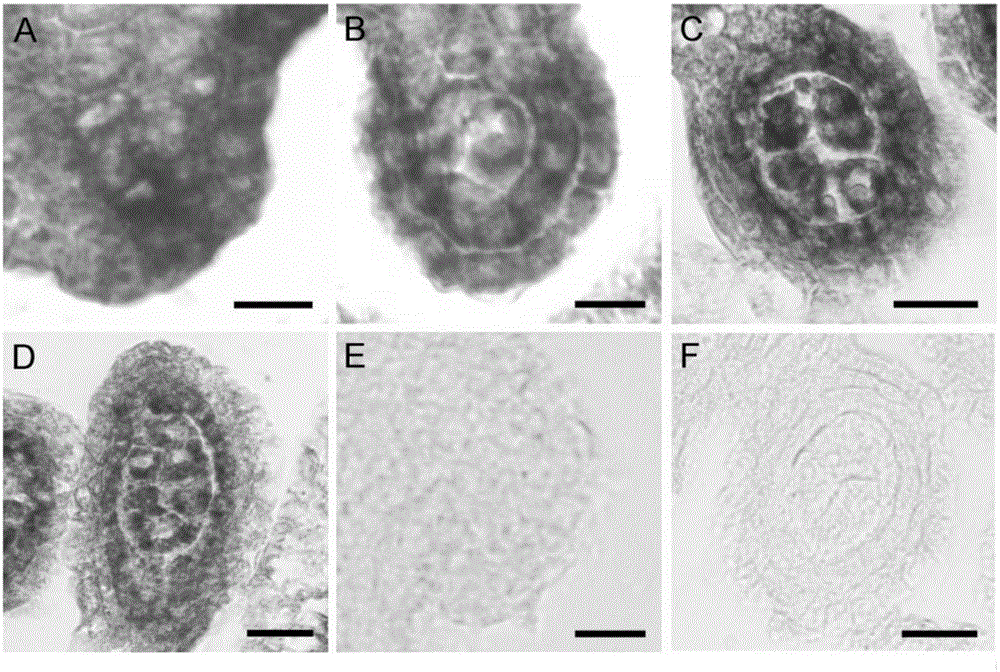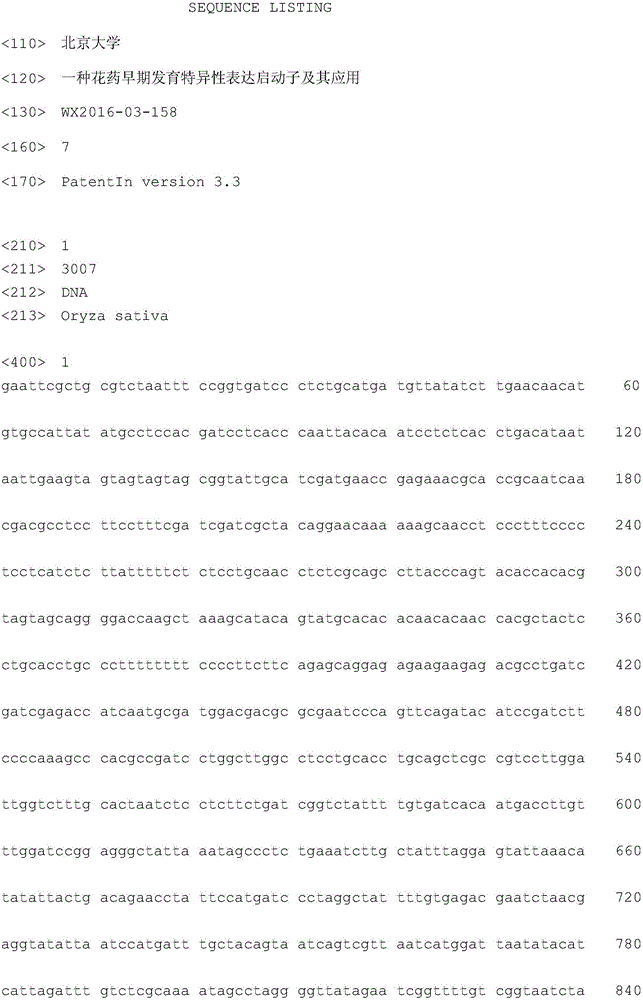Early anther specific promotor and application thereof
A technology in the promoter and sequence list, applied in the field of plant genetic engineering, can solve the problems of destruction, phytotoxic environment, fertility restoration and maintenance of sterility in cumbersome methods, etc.
- Summary
- Abstract
- Description
- Claims
- Application Information
AI Technical Summary
Problems solved by technology
Method used
Image
Examples
Embodiment 1
[0019] Embodiment 1, the cloning of LOC_Os05g42240 gene promoter fragment EASpro:
[0020] The length of 3kb upstream of the start codon ATG site of the rice LOC_Os05g42240 gene was selected as a candidate promoter region, and the genomic DNA of the rice variety Nipponbare was used as a template to amplify using primers F1 and R1 (see below). Subsequently, the amplified PCR product was constructed into the pENTR intermediate vector by TOPO reaction, and then carried out LR reaction with the pHGWFS7 final vector to construct the analysis vector EASpro-GUS with EASpro promoter fused to GUS. Among them, TOPO enzyme and LR enzyme were purchased from Invitrogen, and the pHGWFS7 vector was purchased from Ghent University.
[0021] F1: 5'-CACCGAATTCGCTGCGTCTAATTTCCGG-3' (SEQ ID NO: 2)
[0022] R1: 5'-GGCGGAAGAAGCCGAGAGGTTAGTG-3' (SEQ ID NO: 3)
Embodiment 2
[0023] Embodiment 2, the acquisition of transgenic plants
[0024] (1) Rice callus induction:
[0025]Select plump Nipponbare rice seeds, peel off the seed coat, sterilize and wash, and evenly inject them into the sterilized MS solid medium with 2 mg / L 2,4-dichlorophenoxyacetic acid (2,4-D) , 32 ℃ continuous light for 5 days to induce callus formation.
[0026] (2) Agrobacterium transformation:
[0027] At the same time, the pHGWFS7 vector carrying the EASpro promoter fragment was transformed into Agrobacterium EHA105 competent cells by heat shock method, coated with solid LB medium with 50 μg / L spectinomycin, cultured in the dark at 28°C for 2 days, and screened for positive clones . The obtained positive clones were cultured in the dark at 28° C. for 3 days in solid AB medium containing 50 mg / L spectinomycin for rice transformation.
[0028] (3) Rice callus transformation:
[0029] Take the callus with good growth condition, soak in the bacterial solution for 2 minutes,...
Embodiment 3
[0034] Embodiment 3, the activity analysis of EASpro promoter in anther tissue
[0035] Take the florets of positive transgenic rice at different reproductive stages, and treat them with pre-cooled 90% acetone for 20 minutes; discard the acetone, add 50 mM phosphate buffer (pH 7.2) to rinse twice; absorb and discard the phosphate buffer, and add GUS staining solution (50mM phosphate buffer solution with pH 7.2, potassium ferricyanide 2mM, potassium ferrocyanide 2mM, X-gluc 1mM) appropriate amount, so that the plant material is completely submerged in the staining solution, and vacuumized for 1hr; Stain in the box. After the color development of the plant material is completed, discard the GUS staining solution, add 1mL of 70% ethanol and mix gently to decolorize. Observe and photograph under a stereomicroscope.
[0036] The results showed that in the early stage of stamen primordium differentiation, when the stamen primordium was just raised and the length of the entire flore...
PUM
 Login to View More
Login to View More Abstract
Description
Claims
Application Information
 Login to View More
Login to View More - R&D
- Intellectual Property
- Life Sciences
- Materials
- Tech Scout
- Unparalleled Data Quality
- Higher Quality Content
- 60% Fewer Hallucinations
Browse by: Latest US Patents, China's latest patents, Technical Efficacy Thesaurus, Application Domain, Technology Topic, Popular Technical Reports.
© 2025 PatSnap. All rights reserved.Legal|Privacy policy|Modern Slavery Act Transparency Statement|Sitemap|About US| Contact US: help@patsnap.com



